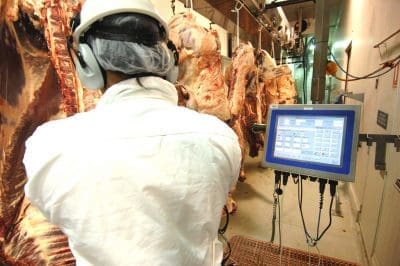DIRECT consignment processor grids across eastern Australia have paused to catch their breath this week, after earlier 20-40c/kg rises since early May.
In southern Queensland, competitive processors this week have four-tooth grass export steer at 680c/kg – up 30c/kg on offers seen just before Beef 2021 started three weeks ago – with quality heavy cows 600c/kg – also up 30c. Central Queensland processing sites are typically 10c/kg behind those rates.
 To refresh readers’ memories, the absolute top of the price cycle seen last year reached 690-695c on four-tooth grass steer, and cows 620c/kg – within sight of current Queensland rates.
To refresh readers’ memories, the absolute top of the price cycle seen last year reached 690-695c on four-tooth grass steer, and cows 620c/kg – within sight of current Queensland rates.
Some MSA cows in Queensland this week are attracting offers of 610c, with certified grassfed MSA steer programs (no HGP, but varying depending on the strength of the audit program) ranging from 700c/kg to 770c/kg.
Reflecting the seasonal tightness of supply heading into winter, southern state grids have also strengthened dramatically since early May, with southern NSW publicly-disclosed grids this week staying in record territory at 695c/kg on four tooth steer and heavy cows 620c. That’s a rise of 30c on cows and a whopping 50c/kg on heavy steers since late April.
A large northern NSW exporter is this week has offers for immediate kills at 570c/kg on heavy cows 275-350kg dressed weight, 6-22mm fat, with a hefty 40c/kg premium for Angus.
Grids representing processors in eastern parts of South Australia reached new records last week, offering a whopping 640c/kg on heavy cows (up from 600c in late April), and 695c/kg on four-tooth steer (up 40c).
Where are the southern buyers?
May normally signals the annual migration of livestock buyers from southern Australian processors flying north for winter, confident in the knowledge they can ‘put wheels under’ a few relatively cheap northern commodity-type cattle, getting them home at, or below their local rates, at a time of year when southern supply is tight.
There’s been little real sign of it this year, however, as northern slaughter rates have not declined enough (relative to prices being paid in southern NSW or VIC) to justify it. Secondly, processor losses across both regions remain high, serving to ‘dis-incentivise’ any procurement from more distant regions, which only attracts a big freight bill.
Herd recovery gathering pace?
There’s been mounting speculation among processors spoken to for this week’s report that beef herd recovery across large parts of Eastern Australia is now showing signs of gathering pace, with potential for a very large calf crop next spring laying the foundations for further momentum.
The Australian Agricultural Co provided a pointer to that, reporting a phenomenal 47pc increase in its calving performance (albeit it off a very low base the year before, due to the combination of drought and flooding in Queensland’s northwest) in its latest annual report released last week.
“There are a lot more older cows 520-540kg that would normally get their heads cut off, that are going back to the breeding paddock in big numbers this year,” one multi-site processor buyer said this morning.
“And the only way to justify paying 500-600c/kg liveweight for young heifers in the current market is to breed from them – not background them for a supermarket program. So there are a lot of breeding resources staying in, or being added to the breeder paddock, because the grass (in many regions, at least) is there this year.”
On top of that, surviving breeders after the drought are not only young, in terms of age profile, but will inevitably be among the more fertile females the industry has ever seen, because of the extent of culling on fertility performance that has occurred since 2019.
Certainly in parts of Queensland, there are cattle producers who have for years specialised as backgrounders – buying weaner cattle to grow out to feedlot entry weights or grass bullocks – who through circumstances this year have paddocks running breeders for the first time in recent memory.
“Some have looked at the backgrounder market, asking $1400 for a young steer, and opted this year for a PTIC heifer or older cow at maybe $400-$500 more, with a calf coming in the spring,” one cattle buyer said.
It all adds up to a very large calf crop late this year, and into next year’s autumn in NSW, some processors across eastern Australia are suggesting.
“While that isn’t going to add significant numbers to kill rosters immediately, we should start to see those calves coming through the system from spring next year, and into early 2023,” one processor said.
However the cattle supply momentum that’s looming in 18 months’ time also brings with it challenges, the processor said.
“Labour wise, we (processors) are coping with the current smaller kills, but what happens when cattle numbers start to grow again?” he asked.
“The industry needs to be starting to build its labour-force again, well in advance of when that next wave of young cattle starts to come forward.”
“If that doesn’t happen, we run the risk of simply not having the capacity to process available stock, as they come forward, due to plant staff shortages. The industry has the killing capacity, in terms of slaughtering, boning and chilling infrastructure, but the manpower to convert a beast into boxed beef is going to be the real pinch-point. We need to be thinking over the horizon to cater for it – there is no point in waiting until spring next year to start that process.”
Beef Central touched on the processor labour challenge issue in this earlier Beef 2021 article.
- Weekly kill statistics will be added to this article later today, when they are released by NLRS
